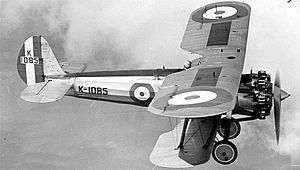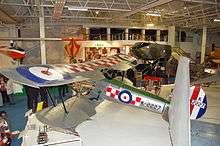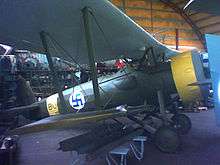Bristol Bulldog
| Type 105 Bulldog | |
|---|---|
 | |
| Role | Fighter |
| Manufacturer | Bristol Aeroplane Company |
| Designer | Frank Barnwell |
| First flight | 17 May 1927 |
| Introduction | 1929 |
| Retired | 1937 |
| Primary users | Royal Air Force Latvian Air Force Finnish Air Force Royal Australian Air Force |
| Number built | 443 (including prototypes and licence built) |
|
| |
The Bristol Bulldog was a British Royal Air Force single-seat biplane fighter designed during the 1920s by the Bristol Aeroplane Company. Over 400 Bulldogs were produced for the RAF and overseas customers, and it was one of the most famous aircraft used by the RAF during the inter-war period.
Background
The design of the Bulldog was the outcome of a series of design studies for fighters undertaken by Frank Barnwell during the 1920s. In 1924 Barnwell had started work on a fighter powered by the Rolls-Royce Falcon to meet the requirements of specification F.17/24. The project was shelved since Bristol preferred to use their own engine designs, but was revived in 1926 when Barnwell started work on a design, designated the Bristol 102, to meet either F.9/26 for a day-and-night fighter or N.21/26 for a shipborne fighter. The Type 105 designation was first applied to a subsequent proposal for another aircraft to meet F.9/26 powered by the Mercury engine then under development at Bristol. These proposals looked promising enough for a pair of mockups to be constructed for inspection by the Air Ministry in February 1927. The two aircraft were similar in design, the interceptor to specification F.17/24 design being slightly smaller and lighter and not equipped with radio. As a result Bristol were asked to revise the design so that it met a later interceptor specification, F.20/27. Subsequently, a prototype aircraft, now designated the Type 107 Bullpup was ordered for evaluation, but the other design did not gain official backing. Nevertheless Bristol considered it promising enough to build a prototype to be entered for the F.9/26 trials as a private venture, powered by a Bristol Jupiter because the supply of Mercurys was expected to be limited.[1]
Design and development
The Type 105 was an unequal span single bay biplane powered by a supercharged Bristol Jupiter VII air-cooled radial engine driving a two-bladed propeller. The structure was all-metal with a fabric covering, using members built up from rolled high-tensile steel strips riveted together. In order to ensure the maximum field of view there was a large semi-circular cutout in the trailing edge of the upper wing and the inboard section of the lower was of reduced chord. Frise ailerons were fitted to the top wing only. It was armed with a pair of 0.303 in (7.7 mm) Vickers machine guns mounted either side of the cockpit.[2][3]
The prototype Bulldog first flew on 17 May 1927. Initial testing was entirely satisfactory and it was delivered to RAF Martlesham Heath in June.[4] After initial consideration of all the types entered to meet the specification, the Bulldog and the Hawker Hawfinch were selected for more detailed evaluation.[5] While the Bulldog's manoeuvrability and strength were praised by the RAF,[6] it had poor spin recovery properties. This was solved by fitting an enlarged fin and rudder, but this modification led to difficulties in taxying in a crosswind.
Accordingly, a second prototype with a lengthened rear fuselage was ordered for further evaluation in comparison with the Hawfinch. In this form, designated the Type 105A or Bulldog Mk. II, it was first flown by Cyril Uwins on 21 January 1928 and shortly afterwards delivered to Martlesham Heath. Performance was so close to that of the Hawfinch that a decision was deferred until the aircraft had been evaluated by service pilots; the eventual choice of the Bulldog was made largely because it was easier to maintain.[5][7] An initial contract for 25 aircraft was placed: Bristol accordingly laid down 26 airframes, the additional example being intended as a company demonstration aircraft. The first of these were delivered on 8 May 1929 and deliveries were complete by 10 October.
Later production aircraft were of a refined version designated the Mk. IIA. This had revised wing spars and a stronger fuselage and was powered by the uprated Jupiter VII F. One production aircraft was modified for use as an advanced trainer: after evaluation by the Central Flying School at Upavon this was ordered by the RAF, the production aircraft differing from the prototype in having slightly swept wings and an enlarged fin to improve spin recovery characteristics.[8]

Operational history
The Bulldog never saw combat with the RAF, although during the Abyssinia Crisis of 1935–36, Bristol Bulldogs were sent to the Sudan to reinforce Middle East Command.
Douglas Bader, better known for his Second World War actions, lost both of his legs when his Bristol Bulldog crashed while he was performing unauthorised aerobatics at Woodley airfield near Reading.
The Bulldog was withdrawn from RAF Fighter Command in July 1937, being primarily replaced by the Gloster Gauntlet.[9] The Bulldog's RAF career was not over though, for the type continued to serve for a few years with Service Flying Training Schools.[9]
The Bulldog was exported to foreign air forces, seeing service with Australia, Denmark, Estonia, Finland, Japan, Latvia, Siam and Sweden.
In 1936, Latvia, intent on replacing its Bulldogs with more modern aircraft, sold 11 Bulldogs to Basque nationalist forces. These became part of the Spanish Republican Air Force in the Spanish Civil War; remaining in use until the Battle of Santander.[10] Ten Bulldogs also saw combat as part of the Finnish Air Force during the Winter War against the Soviet Union, which began in 1939. The Bulldogs fought well against their Soviet opponent, gaining six kills by five pilots for the loss of one of their own,[11] the types shot down being two Polikarpov I-16s and four Tupolev SBs,[11] both of which were superior in terms of technology compared to the Bulldog. The first aerial victory of the Finnish Air Force was achieved by a Bulldog piloted by SSgt Toivo Uuttu on 1 December 1939,[12] over an I-16.[11] The Bulldogs were used in advanced training during the subsequent Continuation War against the Soviet Union.[11]
Variants
- Bulldog Mk. I
- Single-seat day-and-night fighter prototype; two built.
- High-altitude Bulldog
- Modification of first prototype with enlarged wings intended for an attempt on the world altitude record.
- Bulldog Mk. II
- Second prototype and initial production version. Powered by a 440 hp (330 kW) Bristol Jupiter VII radial piston engine; 92 built by Bristol.
- Bulldog Mk. IIA
- Powered by a 490 hp (370 kW) Bristol Jupiter VIIF radial piston engine and revised detail design; 268 built by Bristol.
- Bulldog Mk. IIIA
- Development powered by a Bristol Mercury IV enclosed within a Townend ring with a revised wings and stronger fuselage. Only two built, one of which was converted to become the prototype Mk. IV.
- Bulldog Mk. IVA
- Development of the Mk.III to meet specification F.7/30 for a four-gun day-and-night fighter. Not ordered by the RAF but 17 sold to Finland, armed with two 7.7 mm Vickers guns; 18 built by Bristol.
- Bulldog TM (Type 124)
- Two-seat training version; 59 built.
- "J.S.S.F." (Japanese Single-Seat Fighter)
- Two aircraft license-built by Nakajima Aircraft Works, Japan.
Operators

- Royal Australian Air Force
- No. 1 Squadron RAAF - Bulldog Mk. IIA
- No. 2 Squadron RAAF - Bulldog Mk. IIA
- Finnish Air Force - Bulldog Mk. IVA
- Royal Siamese Air Force Two bought for comparison purposes
- Royal Swedish Air Force Two remaining Bulldog Mk. IIA donated to Finland 1939
|
|
- United States Navy - The U.S. Navy purchased two aircraft between 1929–1930. The aircraft were used for test and trials.
Survivors
Bulldog K2227 (S.No. unknown) survives at the RAF Museum, Hendon. A Bulldog IV A (BU-59, S.No. 7810[13]) survives at the Hallinportti Aviation Museum, Kuorevesi, Jämsä, Finland. A two-seat airworthy replica is being built in the USA.
Specifications (Bulldog II)
Data from Bristol Aircraft since 1910 [14]
General characteristics
- Crew: one
- Length: 25 ft 2 in (7.67 m)
- Wingspan: 33 ft 10 in (10.3 m)
- Height: 8 ft 9 in (2.67 m)
- Wing area: 307 ft² (28.5 m²)
- Airfoil: Upper and lower wing Bristol 1A: Use of Clark YH can not be found. MkIII and IV used RAF 34 and 35. Clark YH is very similar to the 1A
- Empty weight: 2,205 lb (1,000 kg)
- Max. takeoff weight: 3,490 lb (1,586 kg)
- Powerplant: 1 × Bristol Jupiter VII radial piston engine, 440 hp (328 kW)
Performance
- Maximum speed: 155 kn (178 mph, 287 km/h)
- Service ceiling: 29,300 ft (8,930 m)
Armament
- Guns: 2 × 0.303 in (7.7 mm) Vickers machine guns
- Bombs: 4 × 20 lb (9 kg) bombs
See also
- Aircraft of comparable role, configuration and era
- Related lists
- List of aircraft of the RAF
- List of fighter aircraft
- List of aircraft of the Spanish Republican Air Force
References
Notes
- ↑ Barnes 1964, p. 212.
- ↑ Lumsden Aeroplane Monthly August 1991, pp. 460–461.
- ↑ Barnes 1964, pp. 212–213.
- ↑ Mason 1992, p. 193.
- 1 2 Mason 1992, p. 194.
- ↑ Barnes 1964, p. 213.
- ↑ Barnes 1964, p. 214
- ↑ Barnes 1966, pp. 219–220.
- 1 2 Delve 2008, pp. 248–253.
- ↑ Air Enthusiast February 1973, pp. 91–92.
- 1 2 3 4 Perttula, Pentti. "Bristol Bulldog – Mk. IIA and Mk. IVA." Backwoods Landing Strip: Finnish Air Force Aircraft, FAF in Colour. Retrieved: 27 June 2009.
- ↑ Gustavsson, Håkan. "Ylikersantti Toivo Antero Uuttu." Biplane fighter aces: Finland, 4 October 2007. Retrieved: 27 June 2009.
- ↑ Keskinen et al 1981, p. 27.
- ↑ Barnes 1964, p. 230.
Bibliography
- Andrews, C.F. The Bristol Bulldog (Aircraft in Profile No.6). Leatherhead, Surrey, UK: Profile Publications Ltd., 1965.
- Barnes, C.H. Bristol Aircraft Since 1910. London: Putnam, 1964.
- "The Bulldog Breed" Part II. Air Enthusiast, Vol. 4, No. 2, February 1973, pp. 91–95. Bromley, UK: Fine Scroll.
- Crawford. Alex. Bristol Bulldog, Gloster Gauntlet. Sandomierz, Poland/Redbourn, UK: Mushroom Model Publications, 2005. ISBN 83-89450-04-6.
- Delve, Ken. Delve, Ken. Fighter Command 1936-1968: An Operational and Historical Record. Barnsley, South Yorkshire, UK: Pen & Sword, 2008. ISBN 978-1-84415-613-9.
- Granger, Alfred. The Bristol Bulldog (Data Plan No. 2). Hamburg, Germany: Taurus Press, 1973.
- Keskinen, Kalevi, Niska, Klaus, Stenman Kari and Geust, Carl-Frederik. Suomen museolentokoneet (Museum Aircraft in Finland). Espoo, Tietoteos, 1981. ISBN 951-9035-60-5.
- López, Rafael A. Permuy and Artemio Mortera Pérez. Bristol "Bulldog" (I) (Perfiles Aeronáuticos: La Máquina y la Historia 8) (in Spanish). Valladolid, Spain: Quiron Ediciones, 2006. ISBN 84-96016-03-X.
- López, Rafael A. Permuy and Artemio Mortera Pérez. Bristol "Bulldog" (II) (Perfiles Aeronáuticos: La Máquina y la Historia 9) (in Spanish). Valladolid, Spain: Quiron Ediciones, 2006. ISBN 84-96016-04-8.
- Lumsden, Alec. "On Silver Wings – Part 11". Aeroplane Monthly, Vol 19 No 8, August 1991. pp. 458–463.
- Mason, Francis K. The British Fighter since 1912. Annapolis, Maryland: Naval Institute Press, 1992. ISBN 1-55750-082-7.
External links
| Wikimedia Commons has media related to Bristol Bulldog. |
| ||||||||||||||||||||||||||||||||||||||||||||||||||||
| ||||||